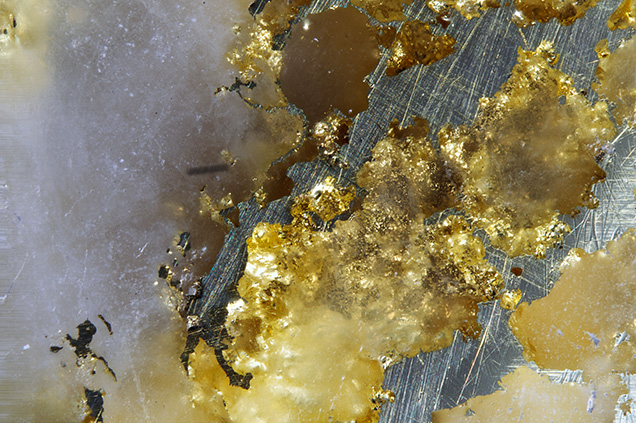Manufactured Gold-in-Quartz Jewelry

Due to its desirability, gold is often imitated with minerals such as pyrite or with gold plating. Gold occurs in small quantities in many kinds of rocks throughout the world. It is typically found in epithermal deposits where hydrothermal fluids deposit gold, along with pyrite and other sulfides, into cracks and faults of rocks—commonly quartz-bearing rocks (J.W. Anthony et al., Handbook of Mineralogy, Vol. 1: Elements, Sulfides, Sulfosalts, Mineral Data Publishing, Tucson, Arizona, 1990). Due to the aggregate structure of this material, the gold contained in natural gold-in-quartz is deposited irregularly, showing a more natural-looking sporadic veining system in the host quartz (figure 1).

The Carlsbad lab was recently sent three jewelry pieces—two bracelets and a ring—for identification reports (figure 2). The ring and one of the bracelets were set with numerous white stones cross-cut with yellow metallic veins. One bracelet had black stones cross-cut with similar yellow metallic veining. Standard gemological testing of both the white and black stones revealed properties consistent with quartz; these results were confirmed with Raman spectroscopy. The Raman analysis of the black stones indicated the presence of amorphous carbon, which drew some suspicion.

These jewelry pieces initially seemed to contain natural gold-in-quartz. Upon further inspection, the yellow metallic veining system appeared inorganic in the host quartz due to its very consistent appearance in all the stones. In the three pieces, the metallic veins had a spiderweb-like structure, and a colorless polymer was also present alongside the metallic veins (figure 3, left). The colorless polymer areas showed undercutting, and the metallic veining had areas of incomplete filling (figure 3, center and right). These features were consistent with the manufactured gold-in-quartz products that were first introduced to the market at the 2005 Tucson shows (Spring 2005 GNI, pp. 63–64). This material was composed of polymer, quartz, and metallic veining similar to what was observed in the stones we examined. Even with the slight difference in the face-up appearance of the natural and manufactured gold-in-quartz, the manufacturer claims that the only way to clearly distinguish this imitation material is with chemical analysis of the metal alloy.
Laser ablation–inductively coupled plasma–mass spectrometry (LA-ICP-MS) analyses were performed on the yellow metallic veins in the white and black stones of each bracelet to further separate them from natural gold-in-quartz. Each ablation spot was drilled twice into the veins. The chemistry of the first spot was very similar for the stones in both bracelets. The vein was mainly composed of gold (Au) and silver (Ag) with traces of nickel (0.90–2.67 parts per million weight, ppmw) and copper (23.58–30.02 ppmw). The gold to silver weight ratio (Auppmw/Agppmw) was between 2.71 and 3.33. The chemistry of the second spot on the same position showed little gold or silver and a significant amount of silica, which indicated that the laser had passed through the yellow metallic layer and into the host quartz below.
One natural gold-in-quartz cabochon obtained from the GIA Museum was analyzed for comparison. The veins found in the natural sample (again, see figure 1) were composed mainly of yellow metallic materials, with additional gray metallic minerals. The same experimental procedures were applied to both the yellow and gray areas. The chemistry of the gray metallic areas identified them as an iron sulfide mineral. The chemistry of the first spot on a yellow metallic area showed a large amount of gold and silver with traces of copper (215–257 ppmw). The gold and silver weight ratio (Auppmw/Agppmw) was between 7.84 and 8.04. It was evident that the concentration of gold in the yellow metallic veins in the natural gold-in-quartz was much higher than that of the yellow metallic veins in the white and black panels of the two bracelets. In addition, the natural veins had a higher copper concentration than the two bracelets.
The manufactured gold-in-quartz materials first reported in 2005 are still circulating in the market today. Consumers should be aware of this when purchasing pieces reported to contain gold-in-quartz. The telling indicator of manufactured gold-in-quartz is the consistent texture of its yellow metallic veins. The gold in the natural version is much more sporadic and appears as chunky conglomerated nuggets.



